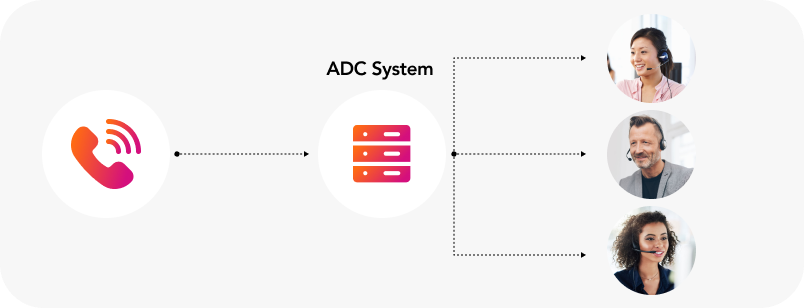Customers agree: the best customer service experience starts with being greeted by a knowledgeable agent who understands their individual needs, pain points and previous interactions with the organization. That applies as much to in-store interactions as online and via inbound phone calls. Customers want to speak to someone who can deal with their issues quickly, allowing them to get on with their day with minimal fuss.
However, an inability to effectively handle inbound calls is a surefire way to alienate customers. Ineffective call management results in customers being left in lengthy hold queues, talking to the wrong agent, being transferred multiple times, reaching an unmonitored voicemail or hitting a dead end completely. As a result, they’re unlikely to call the company back and may take their business to a competitor.
However, organizations can enhance customer service and avoid the risk of losing customers by utilizing call routing software that ensures people always speak to the most relevant call agent.
What Is Call Routing?
Call routing, also known as an automatic call distributor (ACD), is software that automatically answers incoming calls and then directs people to specific agents or groups. The technology ensures customers always get through to the right call agent or business department without having to dial their specific phone number.
Call routing began as hardware solutions that routed calls to the most appropriate agent in call centers. As the modern contact center evolved, new call routing software began to forward customers to the most appropriate agent through computer telephony integration systems (CTIs). This enables agents to seamlessly interact with customers across their preferred channels, from online chat and messaging services to SMS messages and incoming calls.
Furthermore, these routing engines enable businesses to quickly adjust the rules that call routing will follow without requiring IT assistance.

How Does Call Routing Work?
Call routing works through technology that analyzes data to decide where an incoming customer call needs to be diverted to ensure the best possible outcome. This begins with caller input, either through:
- A customer interacts with an interactive voice response system (IVR) to reach the correct department
- The company’s phone system extracts data from its customer relationship management (CRM) system to understand the caller’s intent
Call routing technology automatically identifies a caller’s number and uses predefined criteria and rules to route their call effectively. It also pulls historical data about their interactions with your brand and other demographics to route them to the most appropriate call agent.
Modern contact centers can use attribute-based routing to provide agents with all the information they need about a customer, through leads, support tickets, historical call data and more. This offers deeper assurance that a customer is matched to the call agent with the best knowledge of their issue to solve their problem as quickly as possible. (There are even more powerful call routing systems can automatically direct calls based on specific Google keywords and advertising channels.)
The success of automatic call routing is defined by the rules you put in place to send customers to the right person every time. Common call routing rules that companies implement include:
- Create welcome greetings with information about the business, such as opening hours or specific extension numbers
- Provide options for customers to go directly to a specific department, voicemail service, enter a hold queue or request a callback from an agent
- Give customers an option for how many times a phone should ring before determining whether an agent is available to speak to them
The Pros of Implementing Call Routing
Call routing presents organizations with a wide range of customer experience benefits, including:
Matching the right customer to the right agent
There’s arguably nothing more frustrating for customers and agents alike than an incoming call being routed to the wrong person. Call routing uses data and technology to automatically match the customer and their issue to the most appropriate and knowledgeable agent.
Eliminating call queues
Long queues of people waiting on hold isn’t just frustrating for customers; it also increases the risk of lost business and inevitably leads to agents dealing with angry customers. Call routing prevents this by giving customers the option to reach the agent or department they need to speak with.
Connecting customers faster
Call routing helps you connect customers to the right agent as quickly as possible. Attribute-based routing is especially crucial as it allows you to understand the context of each call and connect the customer to the best-qualified agent with the skills required to solve their challenge.
Boosting agent productivity
Routing customers to the most appropriate agent every time also offers another significant business benefit: improved agent productivity. Incorrect call routing not only upsets customers; it also frustrates agents, who often must perform tasks outside of their role or expertise. Ensuring agents only talk to the correct customer means every agent is utilized as efficiently as possible and works on the right task at the right time. This increases agent productivity as well as satisfaction.
Breaking Down the Types of Call Routing
Call routing presents organizations with a wide range of customer experience benefits, including:
Skills-based routing
A skills-based approach to call routing helps you to guarantee callers are routed to the best-qualified call agent available. The approach factors in an agent’s product knowledge and tracks that against data related to the caller’s intent.
Round-robin routing
A round-robin approach to call routing sees incoming calls distributed equally across your call agents. Using this approach, you ensure all call agents have an equal workload and prevent some people from being overworked while others are underutilized. Round robin uses algorithms to assign an equal share of leads or incoming calls across the contact center.
Time-based routing
Time-based routing sees callers routed to agents based on when they call the business and ensure calls only get routed to live agents. This approach is particularly beneficial if you maintain 24/7 phone lines. For example, you can route calls to an office on the east coast when west coast offices aren’t open, manage international calls or maintain a 24-hour call center.

Implementing Call Routing: Best Practices for Success
Your approach to call routing will directly affect the success of your customer service. The effectiveness of call routing will significantly impact how customers perceive your business and whether they come back to the organization. But you can delight customers by implementing best practices in customer support, including:
Your call routing approach will depend on your organization’s needs and goals. For example, if your priority is to ensure customers are routed directly to a product specialist or subject matter expert, you need to implement a skills-based routing system.
Once you know the approach you need, it’s critical to understand the market and assess the technology available. You need to ensure the call routing solution you implement is compatible with your existing technology stack, then ensure it’s easy for agents to use and simple for customers to navigate.
Whichever approach you choose, it’s vital to ensure call routing delivers on your needs and solves customers’ challenges. The call routing system needs to be easy for customers to reach the person or department they need to speak to, doesn’t result in them being held in long call queues and works effectively. That means testing the system to check for errors and ensure certain options don’t result in calls dropping off.
Having a good handle on your customers’ needs and preferences and understanding the most frequent challenges they call about is crucial to the success of your call routing system. Recognizing a customer’s needs helps you to provide support via their preferred channel, be it through social media, text message, email or on the phone. It will also help you design your call routing system to target customers’ preferences and streamline the process to help people quickly navigate to an agent.
Some callers don’t want to speak to an agent or enter call queues and instead want to be able to solve their issue themselves. Call routing systems can utilize IVRs and virtual assistants to help customers achieve rapid self-service as well as accurately route callers and schedule callbacks. An IVR system can also reduce business costs compared to employing live call agents and boost customer satisfaction.
Overcoming Challenges in Call Routing Implementation
An effective call routing system helps you address common customer service challenges that could drive people away from the business. For example:
- Menu clarity: An issue that often drives customers away is reaching a menu of options that’s unclear or has too few or too many options. This leaves people confused about which option to choose and inevitably leads to them hanging up the phone. Call routing solves this challenge by matching customers to the most appropriate agent and helps them solve their issues more quickly.
- Call abandonment: Sending customers into a long call queue leads to them hanging up and potentially taking their business elsewhere. You can avoid this by using a call routing system to help customers reach the person or department they need to speak to. You can also give people the option to choose their preferred channel or self-serve the issue they’re calling about.
- Agent burnout: Call agents who are overworked or end up speaking to angry customers are a major turnover risk. Call routing ensures the best-qualified call agent handles every incoming interaction, which means happy customers and boosts employee satisfaction.
Streamline Customer Service with Uniphore
Call routing is more than simply a call center technology; it’s a critical solution that can help your business become more efficient, offer streamlined customer support and delight every customer. With an effective call routing system, you can simplify customer service, solve challenges as quickly as possible, and ensure your call agents are productive and enjoy their work. And that ultimately means happy customers that buy more products or services in the future.
Uniphore’s enterprise artificial intelligence (AI) technology helps you better understand your customers, identify new opportunities and enhance agent performance. As a result, your business can automate conversations and maximize the value of every customer interaction.
)
